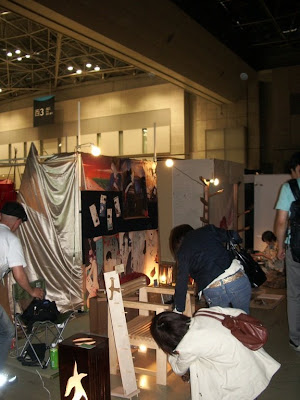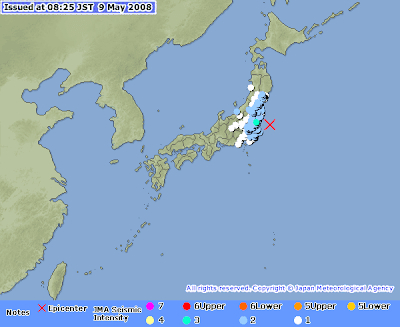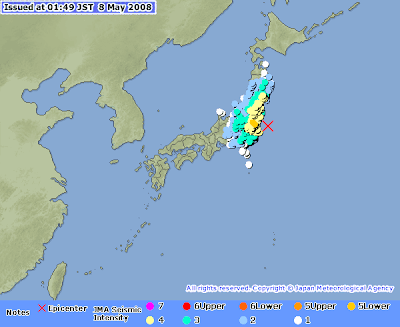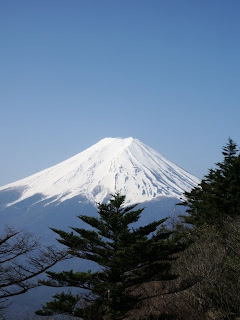ahhhh... Japanese TV
...shown to me by Greg...some quality Japanese TV clips.
A champion speed walker being chased by samurais
..and Darth Vader vs. Japanese Police (i *love* this one!)
A blog, created mainly for my own benefit (as I have the mental retention capacity analogous to a very large aperture sieve trying to hold water), but it also has the dual purpose of letting you guys know what I'm up to. I also have a tendency to prattle on about other stuff too, if I have the time. Check the 'Interlude' thing for updates...or prattles that don't quite make a blog post.
...shown to me by Greg...some quality Japanese TV clips.
A champion speed walker being chased by samurais
..and Darth Vader vs. Japanese Police (i *love* this one!)
Overlord of scripture:
wayway
at
22:00
0
Monkey-do-das
![]()
Labels: Comedy, Japanese quirks
Ok, I stand corrected: there is definitely MORE than just Hard OFF. There is also: GarageOFF [ガレージオフ]
GarageOFF [ガレージオフ]
Car assessories, like stereos, seat covers, spark plugs...stuff like that... OFFHouse [オフハウス]
OFFHouse [オフハウス]
Household goods, such as furniture, white goods for the kitchen and sports equipment...like golf clubs (how this classifies as house, I don't know...) ModeOFF [モードオフ]
ModeOFF [モードオフ]
Clothes HobbyOFF [ホッビオフ]
HobbyOFF [ホッビオフ]
capsule toys, hobby stuff (like skelectrics and Gandam), cards, toys, collectors items, and novelty (who knows what that means...) BoxShop [ボックスショップ]
BoxShop [ボックスショップ]
space rental...basically storage...
Overlord of scripture:
wayway
at
12:33
0
Monkey-do-das
![]()
Labels: Living in Tokyo
 Apparently Book OFF also has a 'sister' shop called Hard OFF, which specialises in hardware, anything from bicycles, pots and pans to air cons and printers. Book OFF, however, focuses mainly on books and although the smaller shops only really stock Japanese books, the larger ones can have a small selection of foreign books. Despite what their name suggests, they don't only do books. We popped into the Mejiro [目白] branch a couple of weekends ago, after having a personal tour of the neighbouring Gakushuin [学習院] University. The first floor was not very interesting, on account that is was jam packed with Japanese books that we are unable to read. The basement floor below, however, was a different matter. There was a trolley full of nearly new consoles, including the Wii (I think it was priced at 21000yen) and following the shelves around, there were games for the DS, Wii, playstation etc. at very reasonable prices. Around the corner there were Box sets for foreign TV shows; CSI, Sex in the City, Buffy, Ally McBeal...which at some point morphed into movies (foreign and Japanese alike) and music. The music section was pretty well stocked out, with a decent range of genres and more or less half price compared to the RRP in mainstream music shops.
Apparently Book OFF also has a 'sister' shop called Hard OFF, which specialises in hardware, anything from bicycles, pots and pans to air cons and printers. Book OFF, however, focuses mainly on books and although the smaller shops only really stock Japanese books, the larger ones can have a small selection of foreign books. Despite what their name suggests, they don't only do books. We popped into the Mejiro [目白] branch a couple of weekends ago, after having a personal tour of the neighbouring Gakushuin [学習院] University. The first floor was not very interesting, on account that is was jam packed with Japanese books that we are unable to read. The basement floor below, however, was a different matter. There was a trolley full of nearly new consoles, including the Wii (I think it was priced at 21000yen) and following the shelves around, there were games for the DS, Wii, playstation etc. at very reasonable prices. Around the corner there were Box sets for foreign TV shows; CSI, Sex in the City, Buffy, Ally McBeal...which at some point morphed into movies (foreign and Japanese alike) and music. The music section was pretty well stocked out, with a decent range of genres and more or less half price compared to the RRP in mainstream music shops.
Unable to resist, we bought ourselves some barginous CD's. I was pleasantly surprised at their immaculate condition, having half expected some kind of scratching or signs of use there was not a mark on them.
List of shops in Tokyo, HERE. There are lots, 142 to be precise.
Overlord of scripture:
wayway
at
10:52
0
Monkey-do-das
![]()
Labels: Living in Tokyo
 Design Festa, 17th - 18th May 2008, Tokyo. Apparently, *THE* biggest art and design show in Asia. We had bought our advance tickets from a local Lawsons (a convenience store) and went down to Odaiba [お台場] on Sunday morning.
Design Festa, 17th - 18th May 2008, Tokyo. Apparently, *THE* biggest art and design show in Asia. We had bought our advance tickets from a local Lawsons (a convenience store) and went down to Odaiba [お台場] on Sunday morning.
We approached Tokyo Big Sight by the most expensive line in Tokyo called the Yurikamome [ゆりかもめ] (well... that's what we used to complain that it was when I lived on the reclaimed bit of sea which can only really be reached by this line...) symbolised by a little seagull (a kamome) - 10 or 15 years ago none of this used to exist...it was just a conveniently shallow bit of sea, that Tokyo absorbed because it has run out of space to expand inland, due to the surrounding mountains...and anyway they've been doing land reclamation for centuries, back when they just used to ram huge beams of wood into shallow sea water...and repeatedly dump sand and material, until they could walk on it...then build on it...Techniques have advanced a little since then... I have been told that the material used to 'reclaim' (not that it really belonged to humans anyway) the land, was mainly taken from metro and trainline tunnelling projects. Reducing the need to waste lots of energy transporting loads of sand pointlessly around the country. ANYWAY...I get distracted by the engineering...as you can probably see, Tokyo Big Sight is a strangely shaped building... looks like four upside-down pyramids on pillars. The entire complex spans much further off into the distance up to about 2 stories in height in what seem like HUGE event spaces. It is damned impressive when you walk through it after a series of lectures or meetings finish... it looks like some kind of human-making-factory (might have mentioned this before...hmmm then again, maybe not...did mention the building here though). There are several other equally strange looking buildings in Odaiba - namely the Fuji Television Building.
 There was quite a queue of people, and we had gotten there EARLY! The thing opened at 11am and there was a line of people waiting...Mind you, it doesn't even come close to the mob that we saw when there was a anime and manga event here a year ago. The horde of people (mainly males...) stretched back to the train station about 8 people wide...and the train station is about 600m away... Our little speck of a queue was nothing compared to that one...none the less, as we saw most people head straight for the first floor, we decided that it might be nicer to go straight to the second floor, where we were hoping it would be quieter.
There was quite a queue of people, and we had gotten there EARLY! The thing opened at 11am and there was a line of people waiting...Mind you, it doesn't even come close to the mob that we saw when there was a anime and manga event here a year ago. The horde of people (mainly males...) stretched back to the train station about 8 people wide...and the train station is about 600m away... Our little speck of a queue was nothing compared to that one...none the less, as we saw most people head straight for the first floor, we decided that it might be nicer to go straight to the second floor, where we were hoping it would be quieter.
Overlord of scripture:
wayway
at
16:37
0
Monkey-do-das
![]()
Labels: Living in Tokyo, Sightseeing
A huge earthquake has hit the SiChuan [四川] Province of China. Reported to have a moment magnitude* of 7.9 (USGS) hit at 2:28pm. In the first few hours of the news being reported they only stated 5 people having died, 4 being children killed when part of a school collapsed and the main damage being burst water mains which were flooding the streets. Hitting in the middle of the day has its pros and cons: on the bright side nearly everyone is awake and has been a wake for a while so should be able (if capable, which may not be the case in such a large earthquake) to react and make some attempt in sheltering and saving themselves, they are not at home and they are not travelling and so would/could/should be a little safer. On the down side the population will be concentrated in the city and if one of those buildings collapses you'll get more casualties in one go. Half a day later, there are reports of 900 odd students trapped in a collapsed university# building and this morning there are photos of lines of bodies which were found buried in the rubble. The first 10 mins of a quake are most likely going to decide your fate, then after that you have to worry about fires...
Hopefully, it wont detract too much attention from Burma, which is still facing a monstrous disaster with the government refusing to allow aid and aid workers in. Which is very curious. Even Iran willingly let in the enemy that is the US to help with the 6.6Mw Bam earthquake 2003, which claimed 50 000 lives (according to Iranian sources, and 31000 according to the USGS).
*Moment magnitude [Mw] is a different magnitude scale from the more commonly recognised Richter scale. There are many magnitude scales for judging earthquakes; Richter is a local magnitude scale and is not really applicable to comparing earthquakes from different regions; Surface wave magnitude [Ms] are based on the amplitude of the surface (Rayleigh) waves which can still be measured a greater distances from the epicentre of a earthquake - more commonly used to describe shallow earthquakes; Body wave magnitude [mb] is used for smaller intra-plate earthquakes with a deep focus, as very few surface waves are generated, and instrumentation would be close enough to pick up the body waves before they are attenuated. All apart from moment magnitude suffer from 'saturation' where the scales become insensitive to further increases in earthquake energy. To put this into perspective the bomb that hit Hiroshima was just over a magnitude 6Mw, and the earthquake that hit Chile in 1960 was a 9Mw. - all this information can be found in Kramer (1996) Geotechnical Earthquake Engineering.
#actually, I would like to correct this, it was a middle school where 900-1000 children/teenagers and teachers are trapped in Juyuan [枸橼], Dujiangyan [都江堰] when one of three school buildings collapsed from 7 stories to about 2m in height. The two other buildings only partially collapsed. There was also a separate case of a different middle school having collapsed with around 100 people inside. article by Xinhua here.
Overlord of scripture:
wayway
at
10:16
0
Monkey-do-das
![]()
Labels: Earthquakes
This guy is SOoooo the duuuude!!! Was being a bit distracted by YouTube and came across this:
He's Japanese and has been on national TV with his vegetable instruments, there's mainly ocarina's made from things like carrots, mouli (the large white parsnip thing), broccoli and a mushroom...other vegetables feature too...its GENIUS!
link: here
Overlord of scripture:
wayway
at
23:57
0
Monkey-do-das
![]()
Labels: Sukoi

Two more earthquakes this morning, 4.5 and 5.7 (Japanese scale), not as big as yesterdays...but brings the total up to 7.
Overlord of scripture:
wayway
at
23:52
0
Monkey-do-das
![]()
Labels: Earthquakes
So far the tally on earthquakes that I have felt since coming to Japan, lies at a measly 5. Two of them were felt last night, the first happened around 130am and was just a gentle rocking of our apartment, whilst the second was the longest and largest that I had felt to date. It lasted about 10-15secs to my reckoning and shook the apartment pretty well, mainly by rattling the doors. At one point I was a little worried that it would get stronger and I did start contemplating getting out of bed to hide under the table or something, but it wasn't necessary.
Anyway, it turns out that these two tremors were caused by quite large earthquakes off Ibaraki prefecture [茨城県沖], JMA magnitudes 6.3 and 6.7 respectively.
The above diagram of seismic intensity (different from magnitude) - the level of shaking that different places felt/experienced is taken from the JMA website for the 6.7 magnitude quake, direct link here.
Overlord of scripture:
wayway
at
11:29
0
Monkey-do-das
![]()
Labels: Earthquakes
Tokyo, and nearly every town in Japan is littered with gaudy Pachinko Parlours, whose façades are plastered with flashing neon lights on every available space, bright colours, and signs displaying interesting forms of English. So, after giving pachinko a try in Kyoto [see earlier post here.] we weren't very convinced...
However, in Ikebukuro [池袋] we wandered into a Taito Games room; which was full of the standard UFO catchers - the grabby arms which are meant to pick up toys but usually end up just stroking them. Anyway we happened upon a heavily evolved version of the 'penny pusher' called GRAND CROSS photo taken from here
photo taken from here
It's based on medals (or tokens) instead of hard currency, which can be bought at machines nearby. Unlike, the traditional penny pushers that I was used to seeing at amusement arcades on seaside promenades where the coins are inserted at the top of the machine through one of three slots, and after bouncing off various pins ends up on the first platform, the tokens are inserted at table level and thrown by the machine at the first platform level. It is possible to adjust the aim of the token shooter, using a lever, you can aim for different parts of the first platform (in theory). On grand cross there are three holes in the sliding platform, which when the tokens are eventually pushed off they can fall into instead of landing on the second platform. If a token falls into one of these holes (called checkers [チェッカー]) then it starts off a fruit machine rolling on the screen in front of you. The fruit machine can let you win a variety of things: more coins (which are shot out into the platforms - and may in turn fall into the checkers to give you more plays on the fruit machine), feature (which i'm not sure what it does), normal balls, and special 'golden' balls. If you get a ball it will be rolled on to your lower platform. If the ball eventually falls off this platform you get to 'challenge the sattelite' - another level in the gambling lottery and one of the many stages to inch you closer to the gold or silver jackpot.
It's all horrendously complex and I'm not entirely sure I understand it all yet. Although, I'm certain that it is a wonderful way to be happy to waste your money.
Overlord of scripture:
wayway
at
01:07
0
Monkey-do-das
![]()
Labels: Sukoi
Day TWO!!! - and after a nice little sleep on the most plastic version of tatami [畳] I have ever come across. I woke up to be able to see a crystal clear sky and Mount Fuji [富士山] out of the window.


 After a quick brekkie of rice, we headed out and turned left out of the hut to get to Mitsu-touge peak...the route passed by the climbing area (which looked fantastic!) and took us past some very strange, plastic-looking ice which covered the ground. The path was heavily eroded, which was rather sad, and some of the wooden steps which had been placed to stop soil from transporting itself down hill had been eroded soo much that they had been completely dug out of the ground.
After a quick brekkie of rice, we headed out and turned left out of the hut to get to Mitsu-touge peak...the route passed by the climbing area (which looked fantastic!) and took us past some very strange, plastic-looking ice which covered the ground. The path was heavily eroded, which was rather sad, and some of the wooden steps which had been placed to stop soil from transporting itself down hill had been eroded soo much that they had been completely dug out of the ground.










Overlord of scripture:
wayway
at
23:50
0
Monkey-do-das
![]()
Labels: Holiday, Outdoors Stuff
On a not particularly sunny monday we headed off to Mitsu touge station [三つ峠駅] via Shinjuku [新宿] and Takao [高尾], the latter station is not very frequent and also not on JR.


Overlord of scripture:
wayway
at
23:03
0
Monkey-do-das
![]()
Labels: Holiday, Outdoors Stuff
 We were looking for a place to buy outdoor gear in Tokyo, and were hoping that we wouldn't have to trek all the way down to Harajuku [原宿] or Shinjuku [新宿] for ICI (Ishii) Sports, or the big sports shops like Victoria or L-Breath* (which are rather pricey, but there are lots of these; some specialising in golf, or ski...in Jimbocho [神保町] Ochanomizu[お茶の水], and since we had just been to Calafate (nice for climbing gear and some more specialised mountain wear, like packs and clothes) in Mejiro [目白] and not found a very wide selection of stuff we figured that Ikebukuro must be big enough to have a decent outdoors shop in it somewhere...
We were looking for a place to buy outdoor gear in Tokyo, and were hoping that we wouldn't have to trek all the way down to Harajuku [原宿] or Shinjuku [新宿] for ICI (Ishii) Sports, or the big sports shops like Victoria or L-Breath* (which are rather pricey, but there are lots of these; some specialising in golf, or ski...in Jimbocho [神保町] Ochanomizu[お茶の水], and since we had just been to Calafate (nice for climbing gear and some more specialised mountain wear, like packs and clothes) in Mejiro [目白] and not found a very wide selection of stuff we figured that Ikebukuro must be big enough to have a decent outdoors shop in it somewhere...
Anyway, I used my incredible Japanese skills at the 'Toshima [豊島] Tourist office' near the East exit of Ikebukuro JR station, on the off chance they knew of a outdoor shop somewhere nearby. As luck would have it, the lovely lady behind the counter pointed us to TWO! The closest was on the same (East) side of the station that we were on and not very far away! hurrah! The other was an L-Breath...bahhhhhh.... So we headed off in the direction in which she pointed us...we climbed the stars to the 2nd floor et voila! a decent sized outdoor wear shop and it seemed to have a decent enough selection of stuff and even a climbing gear section.
It's here:
2F Inside 'D-Box', 1-43-6 Higashi-Ikebukuro, Toshima-ku, Tokyo 170-0013 [〒170-0013, 東京都豊島区,東池袋1-43-6 D-BOX内2F] If you are interested.
Overlord of scripture:
wayway
at
00:48
2
Monkey-do-das
![]()
Labels: Climbing, Ikebukuro, Outdoors Stuff, 池袋

| Earn an online associates degree . |